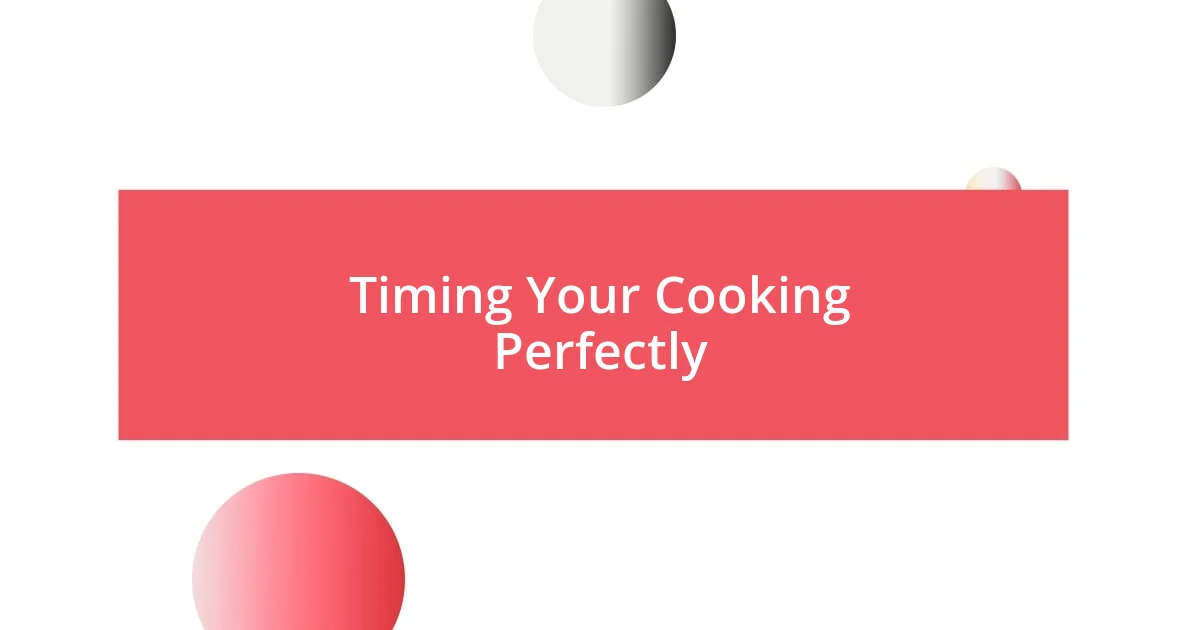Key takeaways:
- Sous vide ensures even cooking through precise temperature control, eliminating uneven doneness typical of traditional methods.
- Selecting high-quality, fresh ingredients and utilizing effective seasoning techniques significantly enhances flavor and texture in sous vide dishes.
- Mastering cooking times and troubleshooting common issues, such as proper sealing and water circulation, are crucial for achieving optimal sous vide results.

Understanding Sous Vide Basics
Sous vide, which translates to “under vacuum” in French, is a cooking technique that involves sealing food in a bag and immersing it in a water bath at a precisely controlled temperature. I remember the first time I tried sous vide; the bubbling water and the aroma wafting from that little pot had me curious and excited. It felt like a science experiment, but one that was bound to end deliciously.
What I find fascinating about sous vide is the consistency it offers. Unlike traditional cooking methods that can lead to uneven results, sous vide ensures that your food is cooked evenly from edge to edge. Have you ever pulled a roast out of the oven only to discover one side was slightly overcooked? With sous vide, that concern disappears.
Temperature control is the heart of sous vide. It allows me to cook proteins to the exact doneness I desire, which is a game changer. I often think back to the time I cooked a steak at 130°F (54°C) for two hours. The perfectly tender, juicy results were nothing short of revelatory. It’s moments like that which truly highlight the magic of this technique.

Choosing the Right Ingredients
Choosing the right ingredients can truly elevate your sous vide experience. I’ve learned that fresh, high-quality ingredients make all the difference. For instance, selecting a prime cut of meat not only amplifies the flavor but also enhances tenderness, giving that melt-in-your-mouth sensation. I still remember a time when I used standard chicken breasts; they were fine, but when I switched to organic, free-range chicken, the flavor burst was extraordinary—it was like a whole new dish!
Additionally, understanding the impact of marinating or seasoning your ingredients before vacuum sealing them is key. I often marinate my proteins hours before cooking, allowing the flavors to infuse deeply. You know that feeling when you bite into something delicious and flavors dance on your palate? That’s what marinating can do, especially with dishes like pork chops or salmon where the flavor can really shine. I once let a pork tenderloin marinate overnight in garlic, rosemary, and olive oil. The taste was so vibrant that I had to share the recipe with friends!
When it comes to vegetables, I’ve found that those chosen for their seasonal freshness can elevate any meal. Root vegetables, for instance, hold up wonderfully in a sous vide bath. I recall cooking a medley of carrots and parsnips, seasoned simply with salt and a drizzle of honey. The result? A sweet, tender side that amazed everyone at my dinner table!
| Ingredient Type | Quality Impact |
|---|---|
| Meat | Prime cuts enhance flavor and tenderness |
| Vegetables | Fresh, seasonal veggies yield better taste and texture |
| Seafood | Fresh fish offers superior flavor and optimal cooking results |
| Herbs and Spices | Using fresh herbs can elevate flavor profile significantly |

Mastering Temperature Control
Mastering temperature control in sous vide is where the magic truly happens. I remember my early days, adjusting the temperature dial with a mix of hope and uncertainty. I once got so obsessed with the numbers, I meticulously tracked my steak’s progress, feeling almost giddy as it approached that target temperature. When I finally sliced into that beautiful medium-rare steak, the sense of accomplishment was extraordinary—each bite was a tender reminder of how precise temperatures can transform a dish.
To help you grasp the importance of temperature control, here are some key points to consider:
- Consistency: Cooking at a fixed temperature ensures even doneness, eliminating surprises at mealtime.
- Precision: Each ingredient has an optimal cooking temperature, crucial for achieving the best flavor and texture.
- Confidence: Knowing you can effortlessly control the cooking process enables you to experiment with new recipes and techniques.
- Safety: Keeping food at the right temperature minimizes the risk of foodborne illnesses, especially with proteins.
- Creative Opportunities: Experimenting with different temperatures invites you to explore textures and flavors that traditional methods can’t provide.
It’s fascinating how just a couple of degrees can make a world of difference. I learned this firsthand while experimenting with egg bites. I once cooked them at 172°F (78°C) for an hour, and the fluffy texture was unlike anything I had tasted before. That moment of discovery ignited my passion for experimentation. Now, I often adjust the cooking time and temperature when I feel adventurous, crafting dishes I never thought possible.

Timing Your Cooking Perfectly
Timing is everything in sous vide, and I’ve learned that perfecting it is like mastering an art form. There have been times when I got so caught up in my sous vide journey that I underestimated cooking times. For instance, I remember preparing a roast and thinking an hour would suffice. When I finally unwrapped it, I was greeted by a lackluster texture. If only I had given it a bit more time, I could have transformed it into a tender masterpiece. It’s those moments that remind me: timing is a critical player in the sous vide game.
I often refer to this technique as a “set it and forget it” approach, but trust me, it’s about more than just hands-off convenience. Understanding how long to cook various foods is essential to achieving that desirable tenderness. For example, I once left short ribs in the sous vide bath for 48 hours, and it turned out to be a game-changer. The richness of the meat melted in my mouth, and my friends still rave about that meal. I find myself asking, how long do you think is “too long” for a piece of meat? The truth is there are few limits; it’s all about knowing your ingredient and making time your ally.
To keep everything on track, I always recommend jotting down cooking times for different ingredients in a handy reference guide. A useful approach I adopted was planning a cooking schedule based on the ingredients I had on hand. Last month, I planned a dinner with friends that included sous vide chicken and veggies. Knowing that the chicken would take about 1.5 hours while the asparagus only needed 30 minutes allowed me to time everything perfectly. I still remember their faces when they tasted the perfectly cooked meal—I felt like a culinary superhero! So, if you’re wondering how to time your cooking perfectly, my advice is to experiment, track your results, and don’t hesitate to take risks!

Enhancing Flavors with Seasoning
When it comes to enhancing flavors, seasoning takes center stage in my sous vide journey. I remember the first time I seasoned a steak before sealing it in the bag—I was a bit apprehensive about how the flavors would meld during the cooking process. But when I finally took that first bite, I realized that the salt and herbs had infused deeply, creating a harmony of flavors that elevated the dish beyond my expectations.
I like to think of seasoning as a gentle invitation for flavors to mingle, rather than just a sprinkle of salt. For instance, using herbs like rosemary or thyme not only complements the main ingredient but also transforms the entire experience. Once, I experimented by adding a sprig of fresh thyme to a bag of carrots. The vibrant aroma that wafted through the air when I opened the bag was nothing short of intoxicating! Have you ever wondered how something so simple can make such a difference? In my experience, it’s all about allowing your ingredients to shine through while giving them that extra oomph they crave.
Don’t overlook the importance of acidity, either—like a squeeze of lemon or a splash of vinegar. I’ve often found that a dash of something tangy can really bring a dish to life after the sous vide cooking is done. The first time I added a touch of balsamic vinegar to a bag of chicken breast, the flavors were so bright and well-rounded that I felt like I had won the flavor lottery. By being intentional with every seasoning choice, I’ve found that I can create meals that not only please the palate but also warm the heart, turning each dining experience into a cherished memory.

Troubleshooting Common Sous Vide Issues
Sometimes, even the best sous vide setup can lead to unexpected hiccups. For example, I once forgot to seal a bag properly, and when I glanced at the water bath, I discovered a little mess floating around. It hit me then that a good vacuum seal isn’t just about aesthetics; it’s crucial to prevent water from leaking in and ruining the food’s texture. Have you ever had that sinking feeling when a recipe goes awry? It reminded me to always double-check or invest in a quality vacuum sealer.
Another common issue is uneven cooking, which can be frustrating. I remember making pork tenderloin and noticed that one end was perfectly done while the other was barely warm. It became clear to me how important it is to arrange food in the bag with enough space for water circulation. I suggest thinking of it like hosting guests—giving each dish some breathing room ensures everyone gets the attention they deserve. So, if you find yourself in a similar pinch, remember that even simple adjustments can make a world of difference.
Lastly, let’s consider temperature fluctuations. I’ve had moments when my sous vide setup experienced slight temperature drops due to a faulty heater, turning an hour-long cook into a guessing game. If you’ve ever been in that situation, you know the anxiety that comes with wondering if your meal is safe. This experience taught me to invest in a reliable immersion circulator and consider using a digital thermometer to monitor everything closely. By being proactive, I’ve turned potential disasters into learning experiences. What troubleshooting lessons have you learned in your kitchen adventures?















